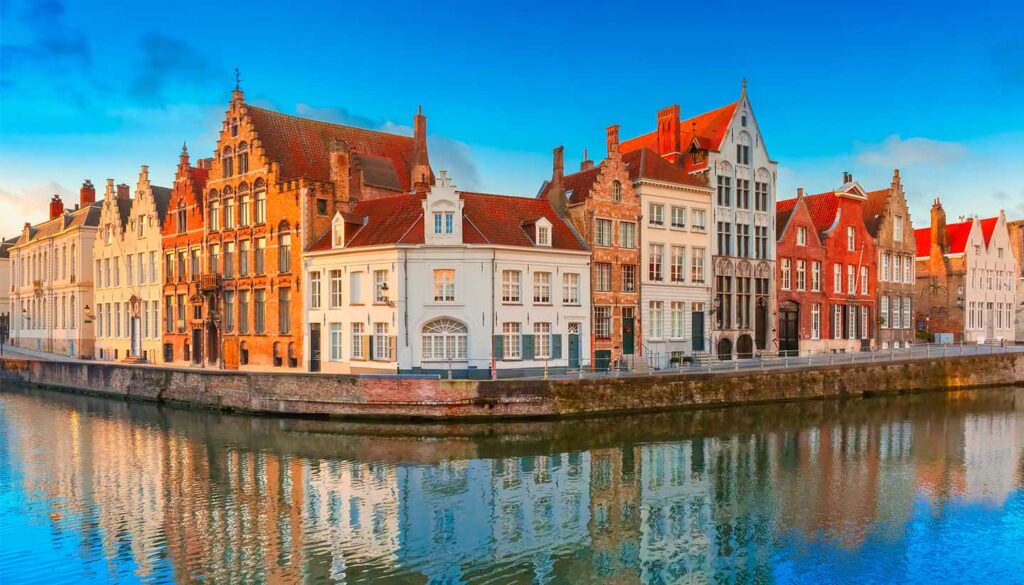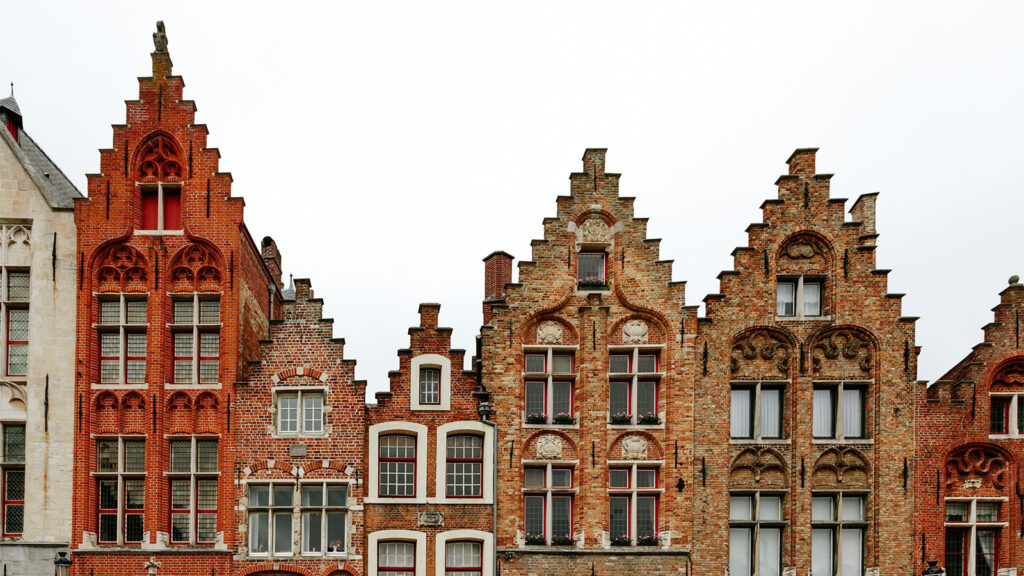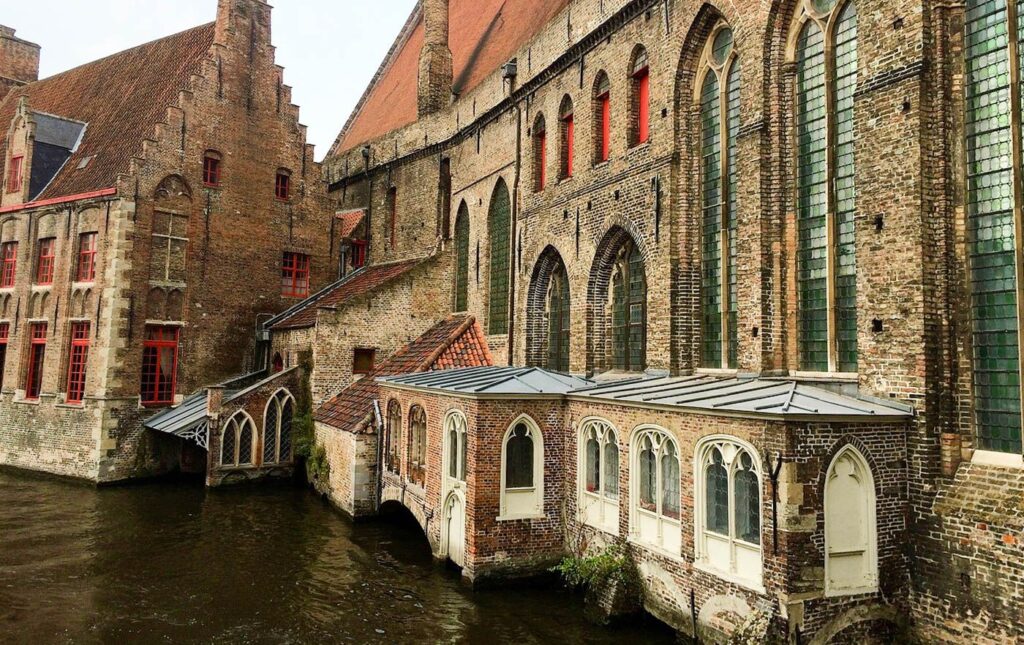Bruges is a town in Flanders, the northern part of Belgium. Relatively cosmopolitan and bourgeois given its compact size, it is one of the best preserved pre-motorised cities in Europe and offers the kind of charms rarely available elsewhere. Bruges is a postcard perfect stop on any tour of Europe.
| Country | Belgium |
|---|---|
| Community | Flemish Community |
| Region | Flemish Region |
| Province | West Flanders |
| Arrondissement | Bruges |
| Government | |
| • Mayor | Dirk De Fauw (CD&V) |
| • Governing party/ies | CD&V, sp.a, Open VLD |
| Area | |
| • Total | 138.40 km2 (53.44 sq mi) |
| Population | |
| • Total | 118,284 |
| • Density | 850/km2 (2,200/sq mi) |
Along with a few other canal-based northern cities, such as Amsterdam and St Petersburg, it is sometimes referred to as the Venice of the North.
Sights
Landmarks, arts, and culture
Bruges has most of its medieval architecture intact, making it one of the best-preserved medieval towns in Europe. The historic centre of Bruges has been a UNESCO World Heritage Site since 2000. Many of its medieval buildings are notable, including the Church of Our Lady, whose brick spire reaches 115.6 m (379.27 ft), making it the world’s second-highest brick tower/building. The sculpture Madonna and Child, which can be seen in the transept, is believed to be the only of Michelangelo‘s sculptures to have left Italy within his lifetime.
Bruges’ most famous landmark is its 13th-century belfry, housing a municipal carillon comprising 47 bells. The city still employs a full-time carillonneur, who gives free concerts on a regular basis.
Craft
Bruges is known for its lace, a textile technique. Moreover, the city and its famous lace would go on to inspire the Thread Routes film series, the second episode of which, shot in 2011, was partly set in Bruges.
Several beers are named after the city, such as Brugge Blond, Brugge Tripel, Brugs, Brugse Babbelaar, Brugse Straffe Hendrik, and Brugse Zot. However, only the latter two—Brugse Zot and Brugse Straffe Hendrik—are brewed in the city itself, in the De Halve Maan Brewery.
Entertainment
- Aquariustheater
- Boudewijn Seapark (an amusement park in Sint-Michiels)
- Biekorf
- Cinema Liberty
- Cinema Lumière (alternative movies)
- Concertgebouw, Bruges (“Concert Building”)
- De Dijk
- De Werf
- Het Entrepot
- Joseph Ryelandtzaal
- Kinepolis Bruges
- Magdalenazaal
- SirkeltheaterStadsschouwburg Brugge
- Studio Hall
Festivals
- Airbag (accordion festival)
- Ars Musica (contemporary music)
- Blues in Bruges
- Brugge Tripel Dagen
- Brugges Festival (world music)
- Cactusfestival
- Elements Festival (electronic)
- Fuse on the Beach (dance festival in Zeebrugge)
- Hafabrugge (orchestra festival)
- Internationale Fedekam Taptoe
- Jazz Brugge
- Koorfestival (“choir festival”)
- Festival van Vlaanderen – MAfestival
- Music in Mind (atmospheric [rock] music)
- September Jazz
- Sint-Gillis Blues – en Folkfestival
- BurgRock
- Comma Rocks Festival
- Red Rock Rally
- Thoprock
Cultural and food festivals:
- Aristidefeesten
- BAB-bierfestival (“beer festival“)
- Brugse Kantdagen (“Bruges’ Lace Days”)
- Chapter 2 (juggling convention)
- Choco-Laté (chocolate festival)
- Cinema Novo (film festival)
- Cirque Plus (circus festival)
- European Youth Film Festival of Flanders
- Ice Magic (ice sculpture festival)
- Jonge Snaken Festival
- Midwinterfeest
- NAFT (theatre festival)
- Poirot in Bruges – Knack thrillerfestival
- Razor Reel Fantastic Film Festival
- Reiefeest (festival on the canals)
Museums and historic sites (non-religious)
Bruges is home to many museums of various kinds. Its art museums include the Arents House, as well as the Groeningemuseum, which has an extensive collection of medieval and early modern art, including a notable collection of Flemish Primitives. Various celebrated painters, such as Hans Memling and Jan van Eyck, lived and worked in Bruges.
The preserved old city gateways: the Kruispoort, the Gentpoort, the Smedenpoort and the Ezelpoort. The Dampoort, the Katelijnepoort and the Boeveriepoort are gone.
The Old St. John’s Hospital (Hans Memling museum) and Our Lady of the Potteries are Hospital museums. Most notably, the city is known for Bruggemuseum (“Bruges Museum”), the general name for a group of 11 different historical museums in the city, including:
- Gruuthusemuseum, a museum for the house of Louis de Gruuthuse.
- Church of Our Lady
- Archaeological Museum
- Gentpoort
- Belfry
- City Hall on the Burg (Bruges)
- Provinciaal Hof (Provincial Court)
- Manor of the Brugse Vrije
- Museum of Folklore
- Guido Gezelle Museum
- Koelewei (Cool Meadow) Mill
- Sint-Janshuis (St. John’s House) Mill
Bruges’ non-municipal museums include the Brewery Museum, Hof Bladelin, Choco-Story (chocolate museum), Lumina Domestica (lamp museum), Museum-Gallery Xpo: Salvador Dalí, Diamond Museum, Frietmuseum (museum dedicated to Belgian fries), Historium (museum of the medieval history of Bruges), Lace centre, St. George’s Archers Guild, St. Sebastian’s Archers’ Guild, St. Trudo Abbey, and the Public Observatory Beisbroek.
Religious sites and landmarks
Bruges, the patron saint of which is Andrew the Apostle, is also known for its religious landmarks. The Basilica of the Holy Blood (Dutch: Heilig-Bloedbasiliek), in particular, is the relic of the Holy Blood, which was brought to the city after the Second Crusade by Thierry of Alsace, and is paraded every year through the streets of the city. More than 1,600 inhabitants take part in this mile-long religious procession, many dressed as medieval knights or crusaders.
Other religious landmarks and museums include the Church of Our Lady, English Convent, Jerusalem Church, Saint Salvator’s Cathedral, St. Trudo’s Abbey, Béguinage (Dutch: Begijnhof), and Ter Doest Abbey (Dutch: Abdij Ter Doest) in Lissewege.





